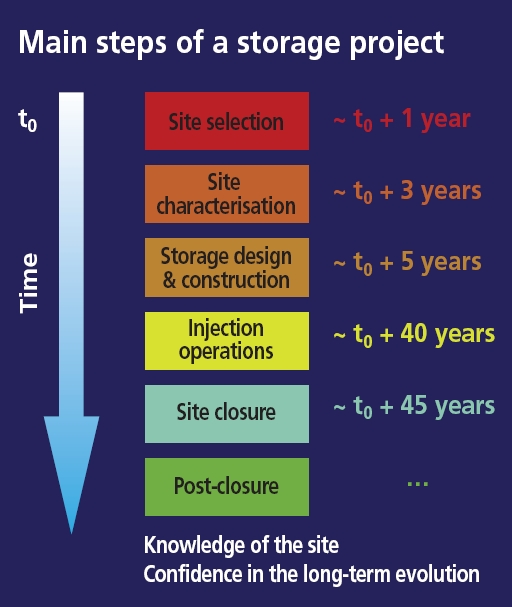
|
What safety criteria
need to be imposed and respected?
|
In order to ensure storage security and efficiency, conditions for project design and operation must be imposed by the regulating authorities and respected by the operators.
Although CO2 geological storage is now broadly accepted as one of the credible options for mitigating climate change, the safety criteria with respect to human health and the local environment remain to be established before industrial-scale operations can be widely deployed. Such criteria can be defined as the requirements imposed upon the operators by the regulating authorities to ensure that impacts on local health, safety and the environment (including groundwater resources) are negligible in the short, medium and long term.
One key issue of CO2 geological storage is that it should be permanent, and consequently, storage sites are not expected to leak. However, the 'what if?' scenario means that the risks must be assessed and the operators required to respect measures that prevent any leakage or anomalous behaviour of the sites. According to the IPCC, the injected CO2 needs to remain underground for at least 1000 years, which would allow atmospheric CO2 concentrations to stabilize or decline by natural exchange with ocean waters, thereby minimizing surface temperature rise due to global warming. However, local impacts need to be assessed on a time scale ranging from days to many thousands of years.
Several main steps can be identified during the lifetime of a CO2 storage project (Fig. 1). Safety will be ensured throughout by:
careful site selection and characterization;
safety assessment;
correct operation;
an appropriate monitoring plan;
an adequate remediation plan.

|
Figure 1
The different steps of a storage project.
|
The associated critical aims are to:
ensure that the CO2 remains in the reservoir;
maintain well integrity;
preserve the physical properties of the reservoir (including porosity, permeability, injectivity), and the impermeable nature of the cap rock;
take into consideration the composition of the CO2 stream, paying particular attention to any impurities not eliminated during the capture process. This is important to avoid any adverse interaction with the well, reservoir, cap rock and, in case of leakage, any overlying groundwater.
Safety criteria for project design
Safety must be demonstrated before operations begin.
With respect to site selection, the main components that must be examined include:
the reservoir and cap rock;
the overburden and particularly the impermeable layers that could act as secondary seals;
the presence of permeable faults or wells that could act as pathways to the surface;
the drinking-water aquifers;
the population and environmental constraints at the surface.
Oil and gas exploration techniques are used to assess the geology and geometry of the storage site. Fluid flow, chemical and geomechanical modelling of the CO2 within the reservoir allows predictions of CO2 behaviour and long-term outcome, and definition of the parameters for efficient injection. As a result, careful site characterization should enable the definition of a normal storage behaviour scenario, corresponding to a site suitable for storage where we are confident that the CO2 will remain in the reservoir.
Risk assessment then needs to consider less plausible scenarios for future states of the storage, including occurrences of unexpected events. In particular, it is important to envisage any potential leakage pathways, exposure and effects (Fig. 2). Each leakage scenario should be analysed by experts and, where possible, numerical modelling applied, in order to evaluate the probability of occurrence and potential severity. As an example, the evolution of the CO2 plume extent should be mapped carefully to detect any connection with a faulted zone. Sensitivity to variations in the input parameters and uncertainties should be evaluated carefully in risk assessment. Estimating potential effects of CO2 on human beings and the environment should be addressed through impact assessment studies, which is usual practice in any licensing process of an industrial facility. In this process, both normal and leaking scenarios will be examined to assess any potential risk linked to the facility.

|
Figure 2
Example of potential leakage scenarios.
|
The monitoring programme, from short to long term, should be established according to the risk-assessment analysis and should control the critical parameters defined within the different scenarios. Its main objectives are to image CO2 plume migration, check well and cap-rock integrity, detect any leakage of CO2, assess groundwater quality and ensure that no CO2 has reached the surface. The remediation and mitigation plan is the last component of safety assessment and aims at detailing the list of corrective actions to be deployed in the event of leakage or anomalous behaviour. It covers cap-rock integrity and well failure, during injection and post-injection periods and considers extreme remediation solutions, such as storage reversibility. Existing know-how encompasses standard oil and gas techniques, such as workover completion, decreasing injection pressure, partial or complete gas withdrawal, water extraction to relieve pressure, shallow gas extraction, etc.
Safety criteria during operation
and post-closure
The main safety concern is associated with the operational phase: after injection stops, the decrease in pressure will make the site safer.
Confidence in the ability to inject and store CO2 in a safe way relies on experience of industrial companies. CO2 is a fairly common product used in various industries, so the handling of this substance does not raise any new problems. The design and control of operations will be based mainly on oil and gas industry know-how, in particular seasonal natural gas storage or enhanced oil recovery (EOR). The main parameters to be controlled are:
injection pressure and flow rate the former should be maintained below fracturing pressure, i.e. the pressure above which fractures are induced within the cap rock;
injected volume, in order to meet predictions defined by modelling;
composition of the injected CO2 stream;
integrity of the injection well(s) and any well located within or nearby the extension of the CO2 plume;
extension of the CO2 plume and detection of any leakage;
ground stability.
During injection, the actual behaviour of the injected CO2 will need to be repeatedly compared against predictions. This constantly improves our knowledge of the site. If any anomalous behaviour is detected, the monitoring programme should be updated and corrective actions taken if necessary. In the case of suspected leakage, appropriate monitoring tools could be focused on a specific area of the storage site, from the reservoir up to the surface. This would detect the ascent of CO2 and, moreover, any adverse impact that could be harmful to drinking-water aquifers, the environment and, ultimately, human beings.
When injection is completed, the closure phase starts: wells should be properly closed and abandoned, the modelling and the monitoring programme updated, and, if necessary, corrective measures taken to reduce risks. Once the level of risk is considered to be sufficiently low, the liability of storage will be transferred to national authorities and the monitoring plan can be stopped or minimized.
The European Directive establishes a legal framework to ensure that CO2 capture and storage is an available mitigation option, and that it can be done safely and responsibly.
In conclusion, safety criteria are essential for the successful industrial deployment of CO2 storage. They have to be adapted to each specific storage site. These criteria will be particularly important for public acceptance, and essential in the licensing process for which regulatory bodies must decide the level of detail for safety requirements.
Source: The European Network of Excellence on the Geological Storage of CO2
<< Previous page
---
Next page >>
TOP
|





